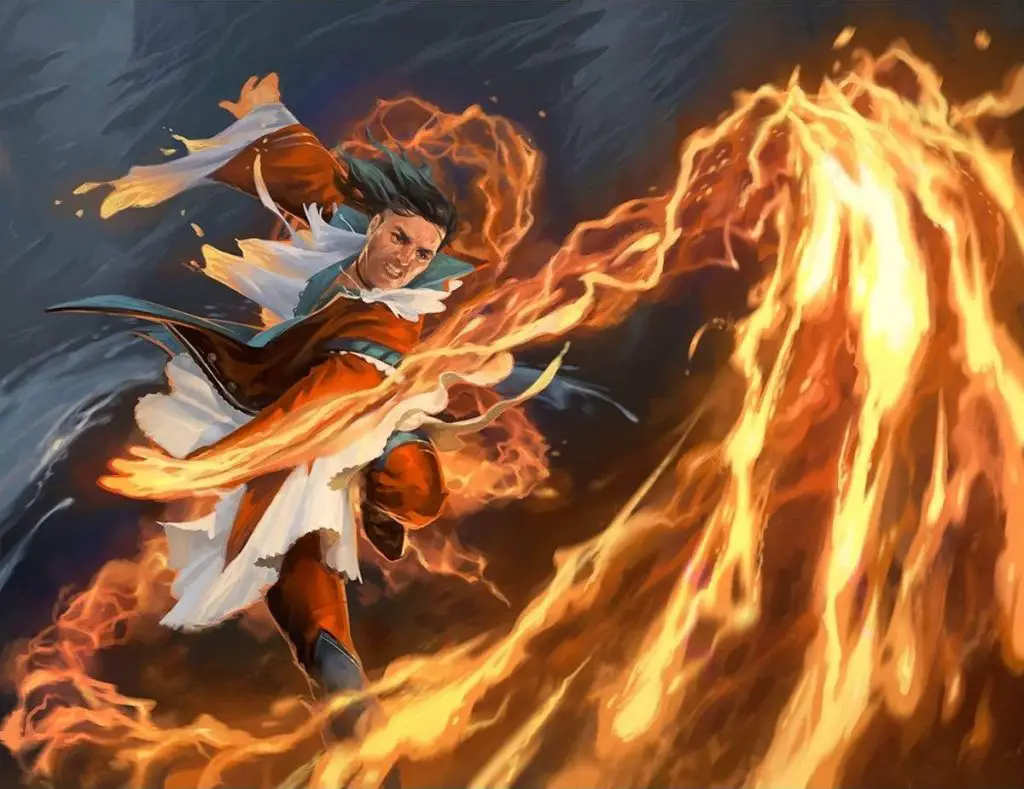Few spells in D&D are as iconic—or as explosively fun—as Fireball.
This spell has been the go-to choice for wizards and sorcerers looking to make a fiery statement since the dawn of D&D. And for good reason!
Whether you’re a seasoned veteran or a fresh-faced apprentice in the arcane arts, understanding the ins and outs of Fireball can elevate your gameplay and leave your enemies as ashes in the wind.
In this article, we’ll dive deep into what makes Fireball such a staple in any spellcaster’s toolkit. We’ll explore its mechanics, share tips on how to wield it effectively, and weigh its pros and cons.
By the end, you’ll be ready to unleash this blazing inferno with confidence and flair. So grab your spellbook, light up that bat guano and sulfur, and let’s set the world on fire—figuratively speaking, of course!
What is Fireball 5e?
Fireball is a powerful 3rd-level evocation spell in D&D 5e, well-renowned for its devastating impact on the battlefield.
This is a spell that does one thing, and oh boy, does it do it well!
When cast, a streak of fire shoots from the caster’s fingertip to a point within 150 feet, erupting into an explosion of flames. This fiery blast engulfs a 20-foot-radius sphere, forcing all creatures within the area to make a Dexterity saving throw.
On a failed save, they take a whopping 8d6 fire damage, or half as much on a successful one.
The spell is not only a favorite for its high damage output but also for its ability to spread around corners and ignite flammable objects. There’s a reason it’s a staple in any spellcaster’s arsenal!
LEVEL: 3rd
CASTING TIME: 1 Action
RANGE/AREA: 150 ft , 20-foot-radius sphere
COMPONENTS: V, S, M*
DURATION: Instantaneous
SCHOOL: Evocation
ATTACK/SAVE: Dexterity Save
DAMAGE/EFFECT: Fire
SPELL LISTS: Sorcerer, Wizard, Cleric (Light Domain), Warlock (Fiend Patron or The Genie Patron), Artificer (Artillerist)
A bright streak flashes from your pointing finger to a point you choose within range and then blossoms with a low roar into an explosion of flame. Each creature in a 20-foot-radius sphere centered on that point must make a Dexterity saving throw. A target takes 8d6 fire damage on a failed save, or half as much damage on a successful one.
The fire spreads around corners. It ignites flammable objects in the area that aren’t being worn or carried.
At Higher Levels: When you cast this spell using a spell slot of 4th level or higher, the damage increases by 1d6 for each slot level above 3rd.
* (a tiny ball of bat guano and sulfur)

How to Use Fireball Effectively
Ah, the sweet symphony of destruction that is that oh-so-classic Fireball!
While it’s tempting to just hurl this spell at every cluster of enemies you see, a true master knows that precision and timing are key to maximizing its potential.
Here’s how to make sure your Fireball hits all the right notes!
Tactical Placement
First up is placement.
The true, raw beauty of Fireball lies in its 20-foot-radius sphere of fiery doom. To get the most bang for your buck, be sure to aim for the densest cluster of foes.
Remember, Fireball affects a 40-foot diameter, so think big! Visualize the battlefield and pick a spot that catches as many enemies as possible while keeping your allies out of the blast zone.
After all, we want to be wary of friendly fire when we’re throwing fireballs around the battlefield. Nothing ruins a party faster than accidentally roasting your Rogue!
Communicate with your team and coordinate your moves to ensure everyone stays a little more “rare” than “well-done.”
Timing and Situational Awareness
Next up, we come to timing.
Casting Fireball at the right moment can turn a tough battle into a cakewalk.
Ideally, you want to unleash it early in the fight when enemies are still grouped up. If you’re quick on the draw, you can catch them before they spread out.
It’s kind of like threading a needle. Well… if the needle were on fire and the thread was a massive explosion, that is…
Resource Management
Lastly, let’s talk about resource management.
Fireball is a 3rd-level spell, which means it’s a fairly significant investment of your magical resources. So use it wisely!
If you’re facing a horde of weaker enemies, a single Fireball can clear the field and save your party a lot of trouble. Your one level 3 spell slot just saved your party a ton of resources they would have needed to take down the swarm of enemies!
For tougher foes, consider using higher-level spell slots to amp up the damage. Each level above 3rd adds an extra d6 to the damage, turning your Fireball from an artillery blast into a full-blown inferno of fiery doom.
By mastering these strategies, you’ll ensure that your Fireball is not just a flashy trick but a devastating weapon in your magical arsenal. So go forth, and may your enemies tremble at the sight of your fiery prowess!
Recommended: Using & Managing the Wizard’s Spellbook in D&D 5e!

Pros and Cons of Fireball 5e
Like any great spell, Fireball comes with its highs and lows. While it’s undeniably one of the most beloved spells in the D&D universe, it’s not without its quirks.
Let’s break down the fiery pros and cons of this explosive evocation!
Pros
- High Damage Output One of the biggest draws of Fireball is its sheer destructive power. With a base damage of 8d6, it can turn the tide of battle in an instant. Few spells can match its raw potential for wreaking havoc on a group of enemies.
- Large Area of Effect Fireball boasts a 20-foot-radius sphere, making it perfect for hitting multiple targets at once. Whether you’re facing a mob of goblins or swarms of other enemies, this spell ensures you can deal significant damage to a wide area.
- Ignites Flammable Objects Got a pesky enemy hiding behind a wooden barricade? No problem! Fireball ignites flammable objects in its radius, adding an extra layer of chaos to the battlefield. It’s a great way to flush out hidden foes or create a distraction.
Cons
- Potential for Friendly Fire With great power comes great responsibility. The large area of effect means you need to be very careful about where you aim. A misplaced Fireball can easily roast your allies along with your enemies. Communication and positioning are key to avoiding unintended casualties or, at the very least, burnt hairs.
- High Resource Cost Fireball is a 3rd-level spell, making it a noteworthy investment of your magical resources. You’ll need to balance its usage with other spells and consider when it’s worth spending a higher-level slot to boost its damage.
- Limited Effectiveness Against Fire-Resistant or Immune Creatures Not all enemies are created equal. Some creatures have resistance or even immunity to fire damage, which can significantly reduce the effectiveness of your Fireball. Knowing your enemy’s weaknesses and strengths is crucial to making the most of this spell.
In the hands of a skilled spellcaster, Fireball is a force to be reckoned with that is capable of instantly turning the tide of virtually any battle. But like any powerful tool, it requires a deft touch and strategic thinking.
Weigh these pros and cons carefully, and you’ll be ready to unleash fiery destruction with confidence and precision!
FAQs – Fireball 5e
Absolutely! Like any spell, Fireball has its counters. Spells like Counterspell can stop it in its tracks if cast in time.
Additionally, creatures with the Evasion trait (like Quicklings) and classes like Rogues and Monks can dodge out of the way, taking no damage on a successful Dexterity saving throw. Fire-resistant or immune creatures will also shrug off much or all of the damage, so always be aware of your enemies’ abilities and traits!
Indeed, there are!
Sorcerers, for example, can use their Metamagic abilities to tweak Fireball in interesting ways. With the “Careful Spell” Metamagic, they can protect allies from the blast, while “Empowered Spell” can reroll low damage dice for a more devastating effect.
Wizards of the Evocation school can use their “Sculpt Spell” feature to exclude allies from Fireball’s area of effect, ensuring friendly fire is a thing of the past.
Each class brings its own unique twist to casting Fireball, allowing for versatile and strategic use of this iconic spell.
Fireball isn’t just about dealing damage; it’s also about creating absolute chaos. The spell’s flames spread around corners, making it great for hitting enemies hiding behind cover.
Additionally, it ignites flammable objects in its radius that aren’t being worn or carried. This means wooden structures, foliage, and other flammable materials can catch fire, potentially adding environmental hazards to the battlefield.
Final Thoughts – Fireball 5e
Thus concludes our deep dive into the fiery world of Fireball.
This spell is more than just a blast of flames; it’s a tactical powerhouse that, when used wisely, can turn the tide of any battle. Whether you’re vaporizing a horde of goblins or setting the battlefield ablaze, Fireball is sure to leave an impression (and some scorched earth) behind.
I hope this guide has ignited your passion for this iconic spell and provided you with the insights needed to wield it with precision and flair.
So now it’s your turn to join the conversation!
Have you had any epic “Fireball” moments in your campaigns? Do you have tips or tricks for using it effectively? Share your stories and thoughts in the comments below—we’d love to hear from our community of spell-slingers!
And before you go, don’t forget to sign up for the Tabletop Joab newsletter. Stay updated with the latest tips, tricks, and guides to elevate your D&D experience!









